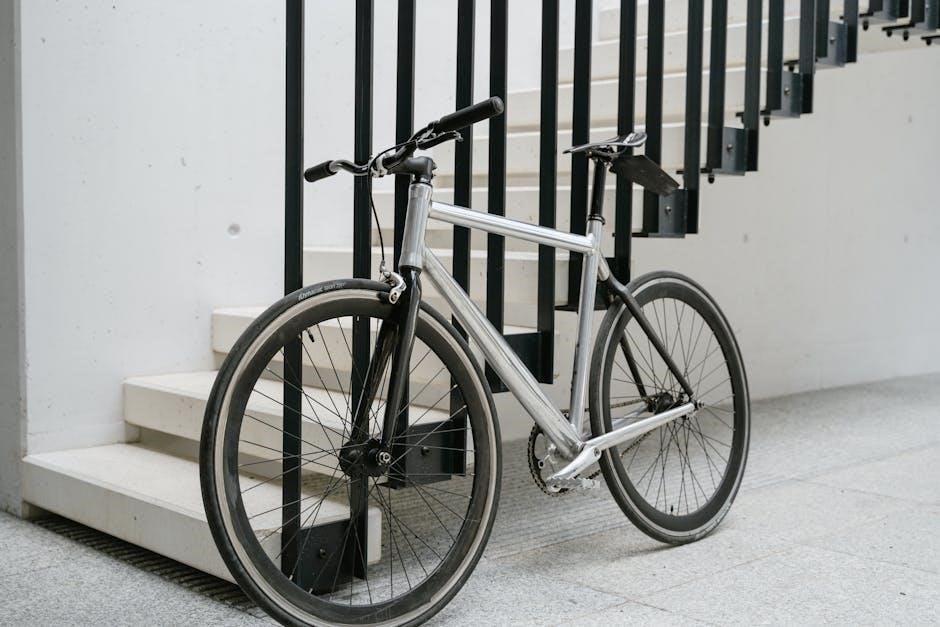
bicycle frame size guide
This comprehensive guide provides essential information on choosing the correct bicycle frame size. We’ll cover measurements, calculations, and charts for adults and kids. Discover the importance of proper fit and explore considerations for women-specific bikes, ensuring a comfortable and efficient riding experience.
Selecting the right bike frame size is paramount for a comfortable and efficient cycling experience. The frame serves as the foundation of the bicycle, and an improperly sized frame can lead to discomfort, pain, and even injury. Understanding the basics of bike frame sizing is crucial for both novice and experienced cyclists. This guide will introduce the key concepts and measurements involved in determining the appropriate frame size for your body and riding style.
Bike frame sizes are typically measured in inches or centimeters, corresponding to the length of the seat tube. However, different bike types (road, mountain, hybrid) utilize varying sizing conventions and geometries. Therefore, it’s essential to consider the specific type of bike you intend to purchase when determining your frame size. Factors such as inseam length, height, and arm reach all play a significant role in finding the perfect fit.
By understanding these fundamental principles, you can confidently navigate the world of bike frame sizing and choose a bicycle that provides optimal comfort, performance, and enjoyment.
Importance of Correct Bike Frame Size
Choosing the right bike frame size is not merely a matter of preference; it’s fundamental to cycling comfort, efficiency, and injury prevention. A frame that’s too large or too small can lead to a cascade of problems, impacting your overall riding experience. An ill-fitting frame can cause discomfort in the back, knees, and wrists, potentially leading to chronic pain and injuries. Proper frame size ensures optimal power transfer, allowing you to ride more efficiently and with less effort.
Furthermore, a correctly sized frame provides better bike handling and control, enhancing safety and confidence on the road or trail. Imagine trying to navigate a winding path with a bike that feels unwieldy and difficult to maneuver. A well-fitted frame becomes an extension of your body, allowing for seamless and responsive control.
Investing the time and effort to determine the correct bike frame size is an investment in your cycling health and enjoyment. It allows you to ride longer, farther, and more comfortably, unlocking the full potential of your cycling adventures.
Measurements for Determining Frame Size: Inseam and Height
Accurately determining your inseam and height is the first crucial step in finding the right bike frame size. These two measurements provide the foundation for calculating the appropriate frame dimensions for your body. Your inseam, the distance from your crotch to the floor while standing with your back against a wall, determines your stand-over height and ensures you can comfortably straddle the bike.
To measure your inseam, stand with your shoes off and your heels against a wall. Place a book between your legs, mimicking the position of the bike saddle. Have someone measure from the top of the book to the floor; This measurement, in inches or centimeters, is your inseam length.
Your overall height, while less critical than inseam, also plays a significant role in determining the correct frame size. Stand straight against a wall, and have someone measure from the top of your head to the floor. Record this measurement as well.

With your inseam and height measurements in hand, you’re ready to consult bike frame size charts and use calculation methods specific to road bikes or mountain bikes. These measurements provide a starting point for finding a frame that fits your body and allows for a comfortable and efficient riding position.
Understanding Stand-Over Height
Stand-over height is a crucial measurement that ensures your safety and comfort when you’re not actively pedaling. It refers to the clearance between the top tube of the bike frame and your crotch when you’re standing flat-footed over the bike. Adequate stand-over height allows you to dismount safely and comfortably without the top tube pressing against your body.
To determine if a bike has the correct stand-over height, straddle the bike while wearing your cycling shoes; There should be at least one to two inches of clearance between the top tube and your crotch for road bikes, and two to four inches for mountain bikes. This extra clearance is essential for mountain biking, where you might need to quickly dismount on uneven terrain.
If the top tube presses firmly against your crotch when you stand over the bike, the frame is too large. Conversely, if there’s excessive clearance, the frame might be too small. While stand-over height is important, it’s not the only factor to consider; Reach, seat tube angle, and other frame dimensions also contribute to overall fit.
Remember, stand-over height is a safety feature. It allows you to comfortably and confidently control the bike in various situations. Prioritize this measurement when selecting a bike frame to ensure a safe and enjoyable riding experience.
Calculating Frame Size for Road Bikes
Determining the correct frame size for a road bike is crucial for comfort, efficiency, and injury prevention. One common method involves using your inseam measurement. To measure your inseam, stand with your back against a wall, wearing cycling shoes. Place a book between your legs, mimicking a saddle, and measure from the top of the book to the floor.

Once you have your inseam measurement in centimeters, multiply it by 0.70. This calculation provides an approximate frame size in centimeters. For example, if your inseam is 80 cm, the calculation would be 80 cm x 0.70 = 56 cm. Therefore, a 56 cm frame size would be a good starting point.
However, this is just a starting point. Frame sizes can vary between manufacturers, so it’s always best to consult a specific brand’s size chart. These charts often correlate height ranges to frame sizes, providing a more accurate recommendation. You can also use online calculators that take into account your height, inseam, and other measurements to estimate your ideal frame size.
Ultimately, the best way to ensure a proper fit is to test ride different bikes and consult with a professional bike fitter. They can assess your riding style, flexibility, and preferences to fine-tune your bike setup and optimize your comfort and performance.
Calculating Frame Size for Mountain Bikes
Calculating the correct frame size for a mountain bike is essential for control, stability, and comfort on varied terrain. Unlike road bikes, mountain bike frame sizes are typically measured in inches. A common method involves using your inseam measurement, similar to road bike sizing, but with a different calculation;
Measure your inseam as described previously. Once you have your inseam measurement in centimeters, multiply it by 0.685. This calculation will give you an approximate frame size in centimeters. Convert this value to inches by dividing by 2.54. For example, if your inseam is 80 cm, the calculation would be 80 cm x 0.685 = 54.8 cm. Converting to inches, 54.8 cm / 2.54 = approximately 21.6 inches. Therefore, a frame size around 21 or 22 inches might be suitable.
Modern mountain bikes often use a “reach” measurement, indicating the horizontal distance from the bottom bracket to the head tube. This measurement, along with stack (vertical distance), provides a more comprehensive understanding of bike fit. Many manufacturers provide size charts that correlate rider height to frame size and reach, making the selection process easier.
Consider your riding style and terrain. More aggressive riders may prefer a smaller frame for increased maneuverability, while trail riders may opt for a slightly larger frame for added stability. Test riding different bikes and seeking guidance from a bike shop is highly recommended for finding the perfect fit.
Bike Frame Size Charts for Adults
Bike frame size charts are invaluable tools for determining the appropriate frame size based on your height and inseam measurements. These charts typically provide a range of recommended frame sizes for different types of bikes, including road bikes, mountain bikes, and hybrid bikes. It’s crucial to understand that these charts offer a starting point, and individual preferences and body proportions may necessitate adjustments.
Road bike size charts commonly use metric measurements (centimeters), while mountain bike charts often use imperial measurements (inches). To use a chart effectively, locate your height or inseam within the chart’s ranges. The corresponding frame size will indicate the recommended size for your body type. For example, a person with a height of 5’8″ might fall within the range for a 54cm to 56cm road bike frame.
Keep in mind that some manufacturers may have slightly different sizing conventions. Always consult the specific size chart provided by the bike manufacturer for the most accurate recommendation. Additionally, consider your riding style and flexibility. Riders with longer torsos or less flexibility may prefer a slightly smaller frame, while those with shorter torsos or greater flexibility may opt for a larger frame.
When in doubt, it’s always best to visit a local bike shop for a professional fitting. A qualified bike fitter can assess your body measurements, riding style, and flexibility to recommend the ideal frame size and bike setup for optimal comfort and performance.
Bike Frame Size Charts for Kids
Sizing kids’ bikes differs significantly from adult bikes, primarily focusing on wheel size rather than frame size. Children’s bikes are typically categorized by wheel diameter, ranging from 12 inches for balance bikes to 24 or 26 inches for junior bikes. Frame size charts for kids are usually organized by age and height, providing a general guideline for selecting the appropriate wheel size. However, it’s crucial to remember that children grow at different rates, so relying solely on age can be misleading.
When using a kids’ bike size chart, prioritize the child’s height over their age. Measure the child’s height accurately and compare it to the chart’s recommendations. Ensure the child can comfortably straddle the bike with both feet flat on the ground and have adequate clearance between the top tube and their crotch. This stand-over height is essential for safe dismounting and preventing injuries.
It’s often best to bring the child to a local bike shop to try out different sizes. A bike shop professional can assess the child’s fit and provide expert advice. Avoid the temptation to buy a bike that’s too large, thinking the child will grow into it. A bike that’s too big can be difficult to handle and may compromise safety. Opt for a size that allows the child to ride comfortably and confidently, promoting a positive cycling experience.
As children progress to larger bikes, consider the bike’s weight and components. Lighter bikes are easier to maneuver, and quality components ensure smooth shifting and reliable braking. Invest in a well-maintained bike from a reputable brand to ensure safety and durability.

Women-Specific Bikes: Considerations
Women-specific bikes are designed to accommodate the typical anatomical differences between men and women. On average, women tend to have longer legs and shorter torsos compared to men of the same height. Consequently, women-specific bikes often feature a shorter top tube and a higher head tube, providing a more comfortable and upright riding position. These adjustments aim to reduce strain on the back, shoulders, and neck.
Another common feature of women-specific bikes is a narrower handlebar, designed to better fit the typically narrower shoulders of women. The saddle is also often wider and more cushioned to accommodate women’s pelvic structure. These bikes may also have shorter crank arms, which can improve pedaling efficiency for riders with shorter legs.
However, it’s crucial to remember that not all women will benefit from a women-specific bike. Individual body proportions vary significantly, and some women may find that a standard bike fits them perfectly well. The best way to determine if a women-specific bike is right for you is to try out different models and compare their fit and feel. Consider factors such as your height, inseam, torso length, and riding style.
Ultimately, the most important factor is finding a bike that fits comfortably and allows you to ride efficiently. Don’t be swayed by marketing or gender stereotypes; choose the bike that feels best for you, regardless of whether it’s labeled as “women-specific” or not. A professional bike fitting can be invaluable in helping you find the perfect bike for your individual needs.
Professional Bike Fitting
While understanding frame size charts and basic measurements is a great starting point, a professional bike fitting takes the process to a whole new level. A bike fit is a comprehensive assessment performed by a trained professional to optimize your position on the bike for comfort, efficiency, and injury prevention. It’s an investment that can significantly enhance your cycling experience, especially if you’re a serious cyclist or experiencing discomfort while riding.
During a bike fit, the fitter will consider various factors, including your flexibility, riding style, and any existing injuries or limitations. They’ll assess your body’s alignment and movement patterns on the bike, making adjustments to saddle height, handlebar position, cleat placement, and other components to achieve the optimal fit. This may involve using specialized tools and software to measure angles and distances accurately.

A professional bike fit can address issues such as saddle soreness, numbness in the hands or feet, knee pain, and back pain; By optimizing your position on the bike, it can improve your pedaling efficiency, allowing you to ride faster and longer with less effort. It can also reduce the risk of overuse injuries, which are common among cyclists who ride with a poor fit.
Bike fitting is not a one-size-fits-all process. A skilled fitter will tailor the fit to your individual needs and goals, taking into account your riding style and any specific concerns you may have. Whether you’re a recreational cyclist or a competitive racer, a professional bike fit can help you get the most out of your cycling experience.